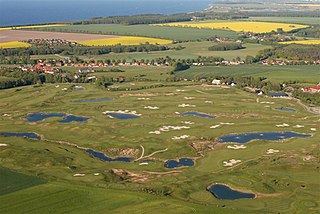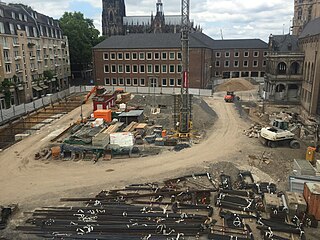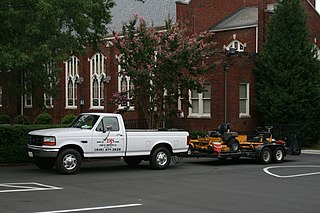
Landscape architecture is the design of outdoor areas, landmarks, and structures to achieve environmental, social-behavioural, or aesthetic outcomes. It involves the systematic investigation of existing social, ecological, and soil conditions and processes in the landscape, and the design of interventions that will produce the desired outcome. The scope of the profession includes landscape design; site planning; stormwater management; erosion control; environmental restoration; parks and recreation planning; visual resource management; green infrastructure planning and provision; and private estate and residence landscape master planning and design; all at varying scales of design, planning and management. A practitioner in the profession of landscape architecture is called a landscape architect.
The following outline is provided as an overview of and topical guide to sustainable agriculture:

Richard Haag was an American landscape architect. He is famous for his work on Gas Works Park in Seattle, Washington and on the Bloedel Reserve on Bainbridge Island. He is also noted for founding the Landscape Architecture Program at the University of Washington and for holding multiple design awards. His designs call to mind the current trend of being one with and improving the environment. Although Al Gore's An Inconvenient Truth is after Richard Haag's heyday, the ideals evoked from the film are shown in his designs. The social movement that created the hybrid car also demanded sustainable design, and Richard Haag provided it in the most distinctive and astounding ways. Richard Haag's modernist and minimalist ideals set the tone for northwestern landscape design and has placed the northwest on the road towards ecologically-minded design.
A garden designer is someone who designs the plan and features of gardens, either as an amateur or professional. The compositional elements of garden design and landscape design are: terrain, water, planting, constructed elements and buildings, paving, site characteristics and genius loci, and the local climatic qualities.
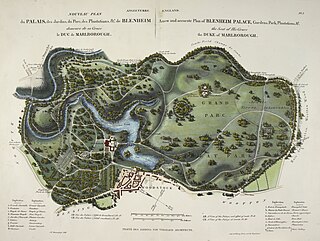
Historic garden conservation is a specialised type of historic preservation and conservation or restoration concerned with historical and landmark gardens and designed landscapes.
The Chicago Botanic Garden is a 385-acre (156 ha) living plant museum situated on nine islands in the Cook County Forest Preserves. It features 27 display gardens in four natural habitats: McDonald Woods, Dixon Prairie, Skokie River Corridor, and Lakes and Shores. The address for the garden is 1000 Lake Cook Road, Glencoe, Illinois. The garden is open every day of the year. Admission is free, but parking is $30 per car.
This is an alphabetical index of articles related to gardening.
Sustainable landscape architecture is a category of sustainable design concerned with the planning and design of outdoor space.
CSIRO Publishing is an Australian-based science and technology publisher. It publishes books, journals and magazines across a range of scientific disciplines, including agriculture, chemistry, plant and animal sciences, natural history and environmental management. It also produces interactive learning modules for primary school students and provides writing workshops for researchers.
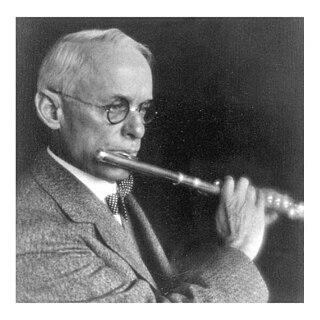
Frank Albert Waugh was an American landscape architect whose career focused upon recreational uses of national forests, the production of a highly natural style of landscape design, and the implementation of ecology as a basis for choices in landscape design. He essentially pioneered the role of the landscape architect as an integral part of national forest design and development through such projects as the Mount Hood Scenic Byway and the Bryce Canyon scenic roadway. His ideas spread via his diverse writings, including Recreation Uses in the National Forests and The Natural Style in Landscape Gardening. He also wrote prolifically about education, agriculture, and social issues in such works as The Agricultural College and Rural Improvement.
This page is an index of sustainability articles.
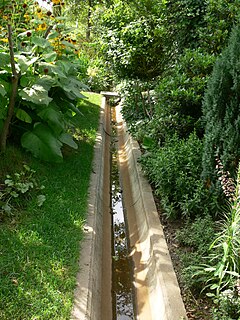
Sustainable gardening includes the more specific sustainable landscapes, sustainable landscape design, sustainable landscaping, sustainable landscape architecture, resulting in sustainable sites. It comprises a disparate group of horticultural interests that can share the aims and objectives associated with the international post-1980s sustainable development and sustainability programs developed to address the fact that humans are now using natural biophysical resources faster than they can be replenished by nature.

A gardener is someone who practices gardening, either professionally or as a hobby.
University of Minnesota College of Design is located on both the Saint Paul and Minneapolis campuses of the University of Minnesota-Twin Cities. The College of Design includes the full range of design disciplines and is home to eight undergraduate majors in the fields of architecture, apparel design, graphic design, interior design, landscape architecture, product design, and retail merchandising. There are 23 graduate degree programs, eight undergraduate minors, nine research centers, and the Goldstein Museum of Design.
This page is based on this
Wikipedia article Text is available under the
CC BY-SA 4.0 license; additional terms may apply.
Images, videos and audio are available under their respective licenses.




